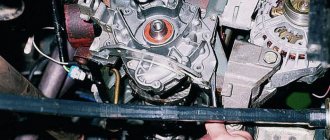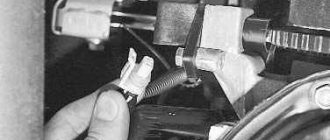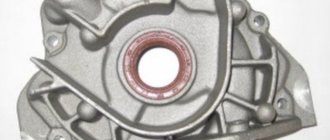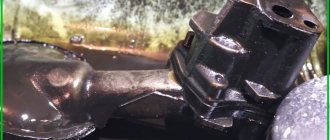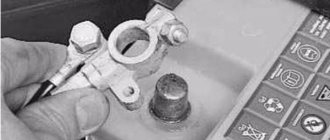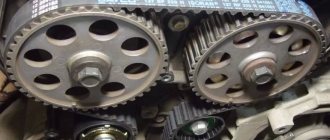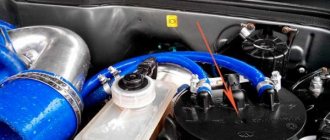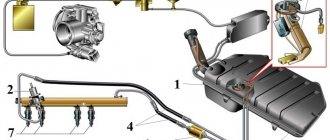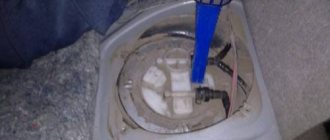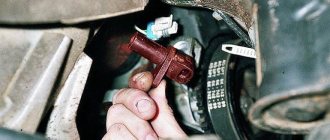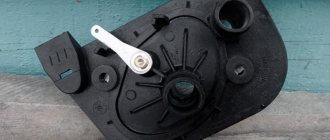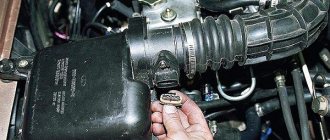A mandatory attribute of the lubrication system of any internal combustion engine is the oil pump pressure reducing valve (OPRN). Many car enthusiasts have no idea about such a part, although its role in ensuring the performance of the engine is very great. It is also worth understanding the structure, operation and malfunctions of this unit because its analogues are present in any systems where compressed liquids or gases are used as a working medium.
Purpose of the oil pump pressure reducing valve
As is known, lubrication of the rubbing surfaces of engine sliding bearings (main, connecting rod, piston pins, bearings, etc.) occurs with a constant supply of engine oil under pressure.
If the pressure is not enough, then wear, overheating and failure of the working parts occur, and if the pressure exceeds the norm, then the motor can suffer serious damage. To avoid this, a pressure reducing valve comes into play.
One interpretation of the term “reduction” is the reduction or weakening of something. In mechanical engineering, a valve is called a pressure-reducing valve when, at a certain peak moment (increasing to the maximum pressure, oil, water, air, gas, etc.) it opens the passage and helps normalize the pressure of the working medium. Thus, the valve mechanism is designed to protect against damage due to excessive increase oil pressure.
Valve device
The oil pump pressure reducing valve has a very simple design.
The main parts are:
- housing with a channel system;
- a valve (ball or small piston) that closes the bypass channel;
- spring;
- stop screw or bolt.
It is easy to understand the principle of operation of the design. The thrust screw creates pressure on one end of the spring, which, by the compression force of the spiral, presses the valve to the socket, which has a through hole in the channel. As soon as the pressure in the channel increases enough to overcome the resistance of the spring, the valve lowers and the oil flows. When the pressure normalizes, the spring returns the valve to its original position, closing the gap.
There are two types of RKMN according to the housing design:
- the entire valve mechanism is completely removed from the oil pump;
- the valve is built into the oil pump housing.
Valve malfunctions and solutions
There are two types of malfunctions in the operation of the oil pump pressure reducing valve:
- the valve does not maintain pressure at the required level;
- the valve does not open when the maximum value is reached.
In the first case, we can only talk about the fact that the spring creates weak pressure. This phenomenon is extremely rare, but if the engine fails to maintain oil pressure, do not forget about the valve. The spring may not cope with the work for various reasons: wear, incorrect selection, installation of a spring that is too soft or defective.
More often, clogging of the lumen or jamming of the valve occurs. This happens when the oil has not been changed for too long, and dirt particles gradually coke on the surfaces. If the engine oil channels are poorly flushed after a major overhaul, chips and debris may collect in them, which can also jam the valve.
“Treatment” of any valve breakdowns consists of disassembling, diagnosing, cleaning the channels and replacing failed elements. Experts strongly recommend replacing the oil pump and the safety valve along with it after each engine overhaul.
1200 rub. for the photo report
We pay for photo reports on car repairs. Earnings from 10,000 rubles/month.
Write:
Oil pump malfunctions can significantly harm a car's engine because they disrupt the normal circulation of engine oil through the system. The causes of the breakdown may be poor-quality oil used, its low level in the crankcase, failure of the pressure relief valve, contamination of the oil filter, clogged oil receiver mesh and several others. You can check the condition of the oil pump either with or without dismantling it.
Signs of a faulty oil pump
There are several typical symptoms of a faulty oil pump. These include:
- Reduced engine oil pressure. This will be indicated by the oil can light on the dashboard.
- Increasing engine oil pressure. Engine oil is squeezed out of various seals and joints in the system. For example, oil seals, gaskets, oil filter connection points. In more rare cases, due to excess pressure in the oil system, the car refuses to start at all. This happens because the hydraulic compensators stop performing their functions, and accordingly, the valves function poorly.
- Increased oil consumption. Occurs due to leakage or waste.
It is necessary to understand that some of them may indicate failure of other elements of the oil system. Therefore, it is advisable to carry out the check in a comprehensive manner.
Checking with a pressure gauge
In fact, there are not many ways to check the oil pump. The performance check is carried out using a pressure gauge - this way you can verify the level of oil pressure. Then you need to dismantle the device and perform troubleshooting followed by repair or replacement.
Every car owner should know how to check the pressure of the oil pump on a car - this will allow it to avoid dangerous consequences for the engine in case of malfunctions.
A pressure gauge is installed instead of an oil pressure sensor. This is the only way that allows you to reliably verify the serviceability or malfunction of oil pumps. In this case, the pump itself does not need to be removed from the engine. You can purchase ready-made kits for measuring pressure in the lubrication system or make the device yourself.
Causes of oil pump failure
The reason why the oil pump has failed can be determined by diagnostics. There are at least 8 main oil pump faults. These include:
- Clogged oil pickup strainer. It is located at the inlet of the pump, and its function is to coarsely filter the engine oil. Like the system’s oil filter, it gradually becomes clogged with small debris and slag (often such slag is formed as a result of flushing the engine with various means).
- Malfunction of the oil pump pressure reducing valve. Usually the piston and spring included in its design fail.
- Wear of the inner surface of the pump housing, the so-called “mirror”. Occurs for natural reasons during engine operation.
- Wear of the working surfaces (blades, splines, axles) of the oil pump gears. It happens both over time of long operation and due to rare changes of (very thick) oil.
- Using dirty or unsuitable engine oil. The presence of debris in the oil can be for various reasons - careless installation of a pump or filter, use of low-quality lubricating fluid.
- Careless pump assembly. In particular, various debris was allowed to get into the oil or the pump was not assembled correctly.
- Drop in oil level in the engine crankcase. Under such conditions, the pump operates at excessive capacity, which causes it to overheat and may fail prematurely.
- Dirty oil filter. When the filter is very clogged, the pump has to make significant efforts to pump the oil. This leads to its wear and partial or complete failure.
Regardless of the reason that caused the partial failure of the oil pump, it is necessary to carry out a detailed check of it and, if necessary, make repairs or complete replacement.
Expert advice
In order to check the operation of the oil pump, you will need a liquid pressure gauge. These devices are available in auto parts stores. You can also use any industrial pressure gauge for these purposes, but you should pay attention to the measuring scale - it must be adequate. Then you should stock up on an adapter, which should be screwed into the sensor hole.
To make an adapter, you need to know the parameters of the mounting hole and thread parameters. Then a sketch is drawn up based on this data. Another option is to show the machine operator an old or broken one, or maybe even a working one, and he will use it to turn the required part.
Experienced drivers know another way to check the serviceability of the oil pump. Here you can do without a turner. They take a faulty or old oil pressure sensor, remove everything inside and make an adapter based on it. For VAZ you can find ready-made tee fittings on sale.
How to determine if an oil pump is faulty
There are two types of pump testing - without dismantling it and with dismantling it. Without removing the pump, you can verify its malfunction only when it is already in a “dying” state, so it is better to remove it to perform detailed diagnostics.
How to check the oil pump without removing it
Before directly testing the pump, it makes sense to check the oil pressure in the system using a pressure gauge. This way you can make sure that the oil pressure light is working correctly and did not light up in vain. To do this, a pressure gauge is screwed in instead of the emergency lamp pressure sensor.
Please note that the pressure value often drops precisely “when it’s hot,” that is, when the engine is warm. Therefore, the test must be carried out on a warm engine and at idle speed. The minimum and maximum pressure values will differ for different machines. For example, for a VAZ “classic” (VAZ 2101-2107) the minimum emergency pressure value is 0.35...0.45 kgf/cm². It is under such conditions that the emergency lamp on the instrument panel is activated. The normal pressure value is 3.5…4.5 kgf/cm² at a rotation speed of 5600 rpm.
On the same “classic” you can check the oil pump without removing it from its seat. To do this, you need to dismantle the distributor and remove the pump drive gear. Next, evaluate her condition. If there are numerous scuffs on its surface on the blades or on the gear axis, then the pump must be dismantled. It is also worth paying attention to the gear splines. If they are knocked down, it means the pump is jammed. This is usually due to debris and/or sludge in the oil.
Repair recommendations
If there are signs of a valve malfunction (for example, a pressure lamp on the dashboard lights up), you must promptly repair the problem.
To do this, remove and disassemble the oil pump. After opening you will see the pressure reducing valve and will be able to assess its condition.
If it's stuck, take it out, wash it in gasoline and don't forget to lubricate it. Similar flushing actions are done with the fuel pump.
Pay special attention to cleaning the valve channels and diagnosing the main elements. If the spring is faulty, it needs to be replaced.
Please note that the installation of a new oil pump (reducing valve) is required after each overhaul of the power unit.
In this case, you can avoid many problems with pressure surges or, conversely, lack of pressure. Once the repair is complete, be sure to check the system pressure to ensure the readings are accurate.
In the future, change the oil promptly, flush the engine and install a new filter at each replacement.
There are no small things in a car. Even the most insignificant at first glance node can play an important role in the overall “orchestra”.
This theory was once again confirmed by the pressure reducing valve, which requires special attention, timely diagnosis and repair. Good luck on the roads and of course no breakdowns.
Let's look at how to test a removed oil pump. The check consists of visual inspection, measurements and comparison of the measurement result with the nominal dimensions.
Unscrew the oil receiver cap together with the pressure reducing valve. It is worth making an effort so that the spring thrust washer does not get lost. Next, note that some bolts will be smaller than others. This bolt should then snap back into place.
Use a caliper to measure the spring. At rest, it should be at least 38 millimeters in length. Then remove the cover, which will have marks from the wear of the gears. If the scoring is deep, then the oil pump has a lot of wear. The cover can be repaired - its plane should be leveled.
Next, remove the drive gear and visually check the condition of its teeth. If there are abrasions and burrs on the teeth, this indicates a lot of wear. The driven gear should also be checked. The main thing about it is the hole in which the fixation axis is located.
Then check the walls of the device housing and the axis of the driven gear. Potholes, grooves, and various defects indicate that debris has entered the working area inside the pump.
Functions of the oil pump pressure reducing valve
For any car engine, keeping all moving parts constantly lubricated is vital. Pistons, crankshaft, and gas distribution shaft need lubrication. The constant circulation of oil in the engine is ensured by the oil pump - without its help, the oil would simply gradually flow down into the engine crankcase (which happens every time you turn off the car). The oil pump provides, in addition to circulation, another very important parameter - operating oil pressure. Insufficient oil pressure in the engine will lead to oil starvation, overheating and rapid wear. Excessive oil pressure will also have an extremely negative impact on engine performance - oil will leak through seals, connections and seals, and can get into other engine systems - fuel and cooling.
If a shortage of motor oil can be avoided by simply pouring enough of it into the engine, then how to deal with its excess pressure? This is exactly what the reduction valve (from the word reduction - lowering, weakening) does for the oil pump. It is usually located on the pump housing itself, although it can sometimes be part of the oil filter. By design, it can be either a removable part or part of the oil pump cover.
Gear
The unit is arranged as follows. The drive and driven gears are installed in its housing. They ensure the movement of lubricant through a special channel into the oil system. Depending on the crankshaft speed, the pump performance changes. If the oil pressure is higher than the permissible standard, then part of the lubricating fluid is directed to the suction part or directly to the crankcase using a pressure reducing valve. Gear pumps do not have automatic adjustment capabilities.
Oil pump pressure reducing valve design
In appearance, the removable oil pump pressure reducing valve resembles a bolt consisting of several parts: a housing with a channel for oil drainage (or several), the valve itself, a spring and an adjusting (thrust) screw. When assembling the engine, the adjusting screw adjusts the spring compression and the valve actuation force.
The oil pressure in the engine depends primarily on the engine speed. When we press the gas pedal, the speed of the oil pump gears and the oil pressure in the engine also increase. As soon as the oil pressure exceeds a certain level, it presses the valve spring and flows through the channel into the engine crankcase until the oil pressure becomes weaker than the spring pressure and the valve closes the channel again.
As you can see, the device is very primitive, but at the same time quite effective.
Rotary
The design of this type of unit is a little more complicated. The device consists of two rotors - driven and driven. Both are enclosed in a housing.
If the pump is unregulated, then the oil that is sucked into the device passes through the rotor blades. If the pressure level in the system is higher than the nominal or calculated pressure, then the pressure reducing valve is activated to relieve excess pressure.
Adjustable devices have a special movable stator equipped with a spring. It regulates and ensures constant oil pressure regardless of the engine speed. The stator is designed to control constant pressure by varying the volume of the cavity between the rotors. To do this, the stator is rotated in the required direction.
Possible malfunctions of the oil pump pressure reducing valve
In the oil pump pressure reducing valve, as in other similar valve devices, two types of malfunctions can occur. The first is the wear of the spring, as a result of which the valve will open even at low pressure and threaten the engine with insufficient oil pressure. The second is, on the contrary, failure to open the valve even with excess pressure due to jamming of the piston (ball) or clogging of the valve hole.
The first type of malfunction can be avoided by monitoring the light bulb or oil level sensor. If it periodically reports insufficient oil pressure (even for a short time), it is worth checking the serviceability of the spring in the valve. After replacing the spring, its compression should be adjusted while simultaneously monitoring the oil pressure in the engine using a special pressure gauge. It is better to entrust this operation to specialists.
As for valve jamming and clogging, this can be avoided by following the established technical regulations for changing engine oil, and periodically conducting an external inspection of the engine for oil leaks. It is recommended not to overheat the engine and change the oil pump along with the valve after a major engine overhaul.
Oil pumps for internal combustion engines of cars
Since different cars are equipped with different types of engines with different operating parameters, the design of oil pumps can also be different. All modifications of these devices are divided into adjustable and unregulated.
With adjustable models, it is possible to change the performance in order to achieve optimal system pressure under different conditions. In the case of unregulated devices, the parameters are adjusted using special pressure reducing valves.
In car engines, gear and rotary type oil pumps are most often installed. In this case, the movement of oil through the system and the creation of pressure is carried out thanks to rotor blades.
In gear type pumps, these same functions are performed due to the movement of gears. They can be made in two modifications - with an external type of gearing or with an internal one. A pump with an external gear has two gears located next to each other, while a pump with an internal gear has one inside the other. With the same performance, the overall dimensions of gear pumps differ according to the type of gearing.
On a hot engine
As the oil temperature drops, its viscosity rises. This is good for efficient pump operation. To obtain adequate measurement results, it is best to measure pressure on a warm engine. Since the oil heats up much more slowly than the coolant, the engine is allowed to run a little longer after reaching operating temperatures.
In the lubrication system of a working engine with a working pump, the pressure should be in the range of 3.5-4.5 kgf per square centimeter at a crankshaft speed of 5600. If the measurement values differ from the nominal value, then the engine will experience a lack of lubrication in some modes.
